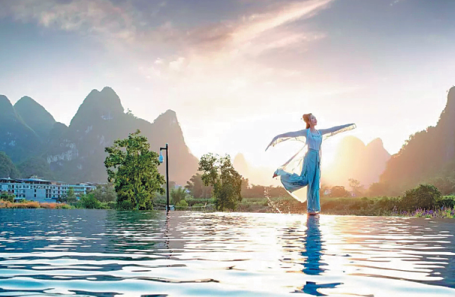Green gems shine
Handicraft workshops, such as those for traditional tuanshan or round fans, also help preserve and promote local heritage.

A visitor dressed in traditional hanfu attire poses for a picture in Sanqianli. CHINA DAILY
In line with the resort's ecological approach, guests can try farming activities to bring them closer to nature, while outdoor enthusiasts can enjoy mountain climbing, paragliding, water sports and other physical pursuits.
Yi Ke, general manager of Guilin Palm Culture Tourism Investment Co which developed the site, says more than 300 village households have retained their homes and farmland, which they can continue to use to complement any work they do in the project as significant stakeholders in the area's growth.
"The residents and visitors all get the opportunity to mingle and interact with each other and nature as part of our long-term sustainable development model," he says.
Steak and stone
At the Ru Zhuo restaurant, on the banks of the Lijiang River and near the city's Elephant Hill scenic spot, French-based cuisine, including pan-seared shrimp salad, beef and codfish with accompanying sauces, are paired with a wide selection of wines from the New and Old Worlds.
Diners are surrounded by priceless stone sculptures dating back to the Western Han Dynasty (206 BC-AD 24), which are part of owner Zhuo Ran's private collection. The unique East-West restaurant spans more than 1,000 square meters and is touted as a one-of-a-kind with its museum-like setting nestled among Guilin's traditional attractions.
Exhibits include a Bixi turtle-like mythological beast carving from the Southern and Northern Dynasties (420-581), frog-shaped "money-ringing" high-relief from the Eastern Han Dynasty (25-220), Taoist statues of the Northern Wei Dynasty (386-534) from Shanxi province and various Gandhara-influenced Buddhist relics.














